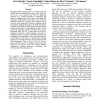Free Online Productivity Tools
i2Speak
i2Symbol
i2OCR
iTex2Img
iWeb2Print
iWeb2Shot
i2Type
iPdf2Split
iPdf2Merge
i2Bopomofo
i2Arabic
i2Style
i2Image
i2PDF
iLatex2Rtf
Sci2ools
ESWS
2005
Springer
2005
Springer
Web Explanations for Semantic Heterogeneity Discovery
Managing semantic heterogeneity is a complex task. One solution involves matching like terms to each other. We view Match as an operator that takes two graph-like structures (e.g., concept hierarchies or ontologies) and returns a mapping between the nodes of the graphs that correspond semantically to each other. State of the art matching systems (e.g., COMA, Cupid) perform well for many real world applications. However, matching systems may produce mappings that may not be intuitively obvious to human users. Moreover, there are cases where matching systems do not produce a useful mapping. In order for users to trust the mappings (and thus use them), they need to understand them. Also, if a system does not provide a mapping or provides a partial mapping, users need to understand answers so that they can understand either why a mapping was not produced or why only a partial answer was produced. In this paper we describe how matching systems can explain their answers using the Inference ...
| Added | 27 Jun 2010 |
| Updated | 27 Jun 2010 |
| Type | Conference |
| Year | 2005 |
| Where | ESWS |
| Authors | Pavel Shvaiko, Fausto Giunchiglia, Paulo Pinheiro da Silva, Deborah L. McGuinness |
Comments (0)

